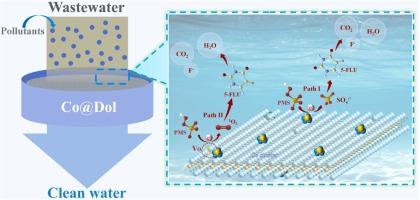白云石上高度分散的钴纳米团簇:一种低成本的催化平台,用于增强过氧单硫酸盐活化,以实现5-氟尿嘧啶的可持续降解
IF 6.3
2区 材料科学
Q2 CHEMISTRY, PHYSICAL
引用次数: 0
摘要
基于过氧单硫酸盐(PMS)的高级氧化工艺在降解有机污染物方面具有重要的潜力。在本研究中,通过简单的水浴沉积-煅烧方法,成功合成了白云石(Co@Dol)上高度分散的钴纳米团簇,实现了PMS高效活化降解5-氟尿嘧啶(5-FLU)。结果表明,Co纳米团簇通过Co- o不饱和配位均匀地锚定在白云岩表面,通过Ca/Mg协同作用实现了优异的电子转移和催化降解效率。当Co负荷为0.58 wt%时,5-FLU的去除率为98.39%,Co浸出浓度为0.327 mg/L。表征和机理研究表明,白云石预分解生成松散结构的阳离子框架,不仅稳定了Co活性位点,而且通过表面碱度促进了PMS解离成SO4•−自由基。丰富的氧空位显著促进了Co2 + /Co3 +的氧化还原循环,确保5-FLU经过5次循环后降解效率保持在95%以上。这项工作提出了一种设计具有成本效益的钴基催化剂的新策略,该催化剂由天然矿物基质支撑。本文章由计算机程序翻译,如有差异,请以英文原文为准。

Highly dispersed cobalt nanoclusters on dolomite: A low-cost catalytic platform for enhanced peroxymonosulfate activation toward sustainable 5-Fluorouracil degradation
Peroxymonosulfate (PMS)-based advanced oxidation processes exhibit significant potential for the degradation of organic pollutants. In this study, a highly dispersed cobalt nanoclusters supported on dolomite (Co@Dol) was successfully synthesized via a simple water-bath deposition–calcination method, enabling efficient activation of PMS for the degradation of 5-fluorouracil (5-FLU). The results demonstrate that Co nanoclusters are uniformly anchored on the dolomite surface via Co-O unsaturated coordination, achieving exceptional electron transfer and catalytic degradation efficiency through synergistic Ca/Mg interactions. With a low Co loading of 0.58 wt%, a removal rate of 98.39% for 5-FLU was achieved, while the Co leaching concentration remained as low as 0.327 mg/L. Characterization and mechanistic studies reveal that the pre-decomposition of dolomite yields a loosely structured cationic framework, which not only stabilizes the Co active sites but also enhances the dissociation of PMS into SO4•− radicals via surface alkalinity. The abundant oxygen vacancies significantly promote the Co2⁺/Co3⁺ redox cycling, ensuring that the degradation efficiency of 5-FLU remains above 95% after five cycles. This work presents a novel strategy for designing cost-effective cobalt-based catalysts supported by natural mineral substrates.
求助全文
通过发布文献求助,成功后即可免费获取论文全文。
去求助
来源期刊

Journal of Alloys and Compounds
工程技术-材料科学:综合
CiteScore
11.10
自引率
14.50%
发文量
5146
审稿时长
67 days
期刊介绍:
The Journal of Alloys and Compounds is intended to serve as an international medium for the publication of work on solid materials comprising compounds as well as alloys. Its great strength lies in the diversity of discipline which it encompasses, drawing together results from materials science, solid-state chemistry and physics.
 求助内容:
求助内容: 应助结果提醒方式:
应助结果提醒方式:


